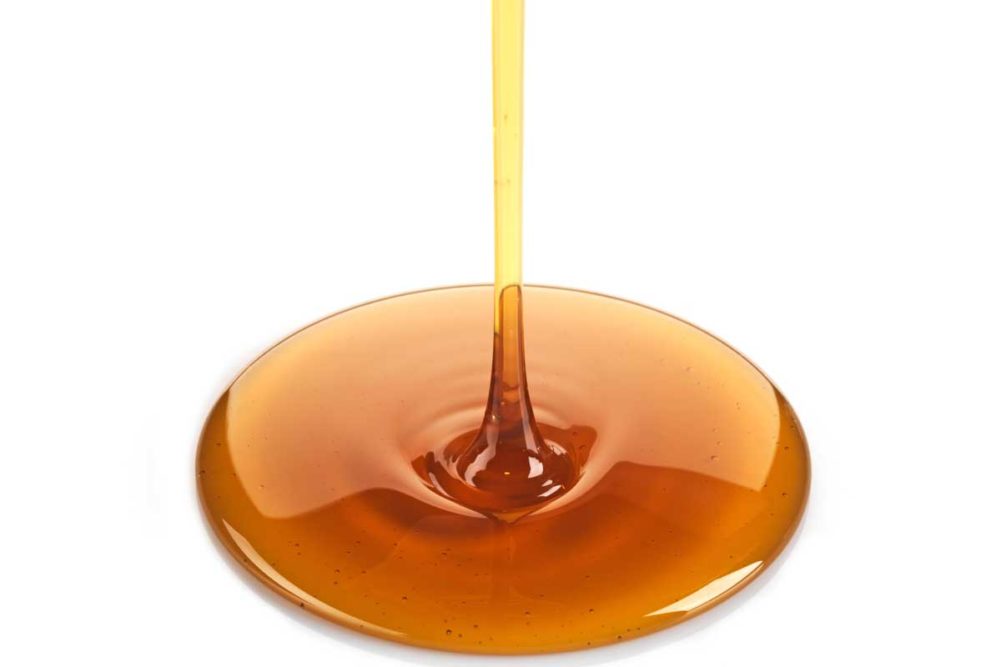Valued for their ability to sweeten products, bind ingredients and add color or flavor to baked foods, viscous sweeteners are derived from a variety of plant-based sources. Several viscous sweeteners rely on the sugars found in grains such as corn, oats and sorghum. Others are made from sugar beet or sugarcane.
Basic corn syrup, for example, is starch extracted from corn kernels treated with an acid or enzyme to create a sweet syrup. HFCS takes that corn syrup a step further by using enzymes to break down some of the glucose into the sweeter-tasting fructose sugar.
Molasses is a natural byproduct of the manufacture of granulated sugar from sugar beet or sugarcane. It is the thick, brown syrup that remains after the extracted juice is boiled down and cooled to form sugar crystals. The molasses may go through many boils; each time, sugar crystals get removed and the syrup thickens, concentrating the flavor and nutrients while intensifying in color. Blackstrap is the darkest molasses available. It has a bittersweet flavor and is loaded with vitamins and minerals.
“Generally, molasses boosts spice flavors such as cinnamon and ginger in baked goods, which provides cost-in-use benefits,” said Tom Sanders, global applications manager, ASR Group-DFI Specialty Ingredients. “Molasses can also increase the viscosity of doughs to make them easier to handle and process.”
Its use is limited by its strong earthy flavor notes and dark color. It is less sweet than sugar and usually used with other sweeteners. As a result, sometimes molasses is added more for flavor and color than sweetness.
“Using syrups high in fructose really helps with moisture retention in cakes, cookies and other chemically leavened bakery products due to the hygroscopic nature of the sugars in these syrups,” explained said Tim Christensen, research and development, bakery applications, Cargill. “Syrups can also help limit sugar crystallization, keeping cookies soft, preventing glazes and water icings from separating, and limiting sugar bloom on donuts.”
[Related reading: What liquid sweeteners bring to the bakery]
Cargill’s tapioca syrup portfolio includes a lower-DE syrup that provides a neutral taste and adds mouthfeel while preventing crystallization. The mid-range (43 DE) tapioca syrup is mildly sweet and helps bind ingredients together and also contributes to mouthfeel.
“Our 63 DE and 50% high-maltose syrups add more sweetness, help with moisture and humectancy, and improve body,” said Dave Lindhost, technical services manager, Cargill. “We even have an option for sugar-conscious formulation. This reduced-sugar tapioca syrup enables sugar reductions of 20% or more while still providing the benefits of a viscous sweetener, including binding and clean taste.”
The company’s corn syrup portfolio includes options for less sweet applications along with HFCS for intense sweetness.
“We have liquid dextrose corn syrup that is ideal for products that need high fermentation,” Mr. Lindhost said. “The high sweet HFCS helps with crust color and humectancy. To keep sugar levels in check, our reduced-sugar corn syrup can help reduce sugar content by 20% or more.”
Malt Products Corp. offers a wide range of viscous sweeteners, from grain-based formulas such as malt and oat extracts to agave, corn and molasses-based liquid sweeteners. They offer functional, nutritional and flavor advantages.
“Meanwhile, they also offer crystallization control, which is particularly crucial in the baking segment because too much crystallization can mimic premature staleness,” said Peeyush Maheshwari, director of business development, Malt Products Corp.
Liquid malt extract tastes like molasses while not being as sweet as sugar or honey. Used at 1 to 3% in yeast-raised doughs, malt extract delivers sweet, malty/caramel flavor that improves the overall flavor and color of the finished product. It is functional as well. It enhances fermentation, improves browning, softens and improves the crumb, and extends shelf life.
“Malt extracts are natural humectants that retain moisture in baked products, delaying the staling process,” said Wiwid Paramita, technical sales specialist, Briess Malt & Ingredients Co. “Malt extract gives bagels their expected flavor and helps develop color on the surface.”
[Related reading: Which natural sweeteners can bakeries use to reduce sugar content?]
Rice syrups and tapioca syrups, Mr. Sanders added, are commonly used in cereal bars and granola where their high viscosity binds ingredients together while complementing nut and grain flavor profiles.
“Dark syrups, such as molasses, can be used in combination with the more expensive honey to synergistically extend the honey taste and reduce the overall cost,” Mr. Sanders said.
Most high-intensity sweeteners are available in liquid format with the amount of water influencing viscosity. The water may dilute these sweeteners’ flavor profiles, but their high-intensity allows the sweetness to still come through. Allulose is the exception.
“Allulose is a sweetener that tastes and functions like sucrose and is in the family of rare sugars,” said Joanne Wang, sweetener technical service customer solutions, Ingredion, Inc. “Allulose is absorbed by the body but not metabolized, making it nearly calorie-free. Allulose is one of the many types of monosaccharides that exist in nature in small quantities and can be found in certain fruits, including figs, raisins and jackfruit. Allulose has a texture and performance behavior like sucrose, providing comparable bulk, sweetness and functionality.”
In bakery products, it has a similar browning effect as fructose. Liquid allulose reduces calorie content while delivering a caramelized flavor note in the finished product. In some products, allulose can replace HFCS while maintaining a moist, tender texture over the shelf life. That’s because allulose has a high humectancy, which makes it suitable for soft baked goods and chewy cereal bars.
“Determining which viscous sweetener to use is highly dependent on the application and the desired finished product,” Mr. Lindhost concluded. “It’s worth noting they don’t have to do it all alone. Formulators can use syrups in conjunction with other sweeteners to provide the desired finished product profile.”
This article is an excerpt from the June 2020 issue of Baking & Snack. To read the entire feature on sweeteners, click here.






